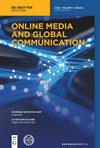从传统主义者到z世代:美国代际传播和媒体偏好的概念化
引用次数: 0
摘要
摘要目的本文将生活在美国的七代人用每代15年的矩阵进行分类。本文介绍了当今美国作为雇员和消费者活跃的五代人的沟通风格:传统主义者、婴儿潮一代、X一代、千禧一代和z一代。本文提出了提高代际沟通效率的策略。设计/方法/方法本文是一项多方法定性研究的结果,该研究通过对10位全球商业企业家的深度访谈和作为大学教授对gen和GenZ学生的参与观察得出数据。组织需要考虑采用特定世代的社交媒体应用程序进行双向沟通。本文揭示了目前活跃在美国劳动力和市场上的五代人的沟通偏好:传统主义者、婴儿潮一代、X一代、千禧一代和z一代。对于任何组织的可持续性来说,研究当今美国活跃在劳动力和市场中的五代人的沟通偏好是至关重要的。为了实现代际沟通效率,公司/组织需要(1)将代际沟通概念化为跨文化沟通的一种形式;(2)制作清晰的“愿景陈述”;(3)用简单的语言与各代人沟通;(4)通过大众媒体和社交媒体进行双向沟通。正在进行的数字化转型对美国的组织沟通产生了巨大的影响。本研究运用“言语密码理论”和“新闻找我”的观点,提出将代际交际视为跨文化交际。公司和组织面临着管理、整合和吸引五代员工和客户的挑战,他们成长于不同的经济时代,受到不同的技术和媒体的影响。这是第一个综合了活跃在美国劳动力和市场上的五代人的沟通偏好的学术研究。这种多方法方法结合了对10位来自传统主义者、婴儿潮一代和X一代的全球商业领袖的深入访谈的第一手数据,以及作为美国教授对千禧一代和z一代学生的参与观察。本文章由计算机程序翻译,如有差异,请以英文原文为准。
From the Traditionalists to GenZ: conceptualizing intergenerational communication and media preferences in the USA
Abstract Purpose This paper categorizes the seven generations of people living in the USA with a 15-year per generation matrix. This paper presents the communication styles of five generations active as employees and consumers in the USA today: the Traditionalists, Baby Boomers, Generation X, Millennials (GenY), and GenZ. This paper provides strategies for more efficient intergenerational communication. Design/methodology/approach This paper is the result of a multi-method qualitative research that crystallizes data from in-depth interviews with ten entrepreneurs in global business and participant observation as a college professor for GenY and GenZ students. Findings Organizations need to consider adopting generation specific social media apps for two-way communication. This paper unveils the communication preferences of five generations currently active in the workforce and marketplace in the USA: The Traditionalists, Baby Boomers, Generation X, Millennials (GenY), and GenZ. Practical implications For the sustainability of any organization, it is critical to study the communication preferences of the five generations active in the workforce and marketplace in the USA today. In order to achieve intergenerational communication efficiency, companies/organizations need to (1) Conceptualize intergenerational communication as a form of intercultural communication; (2) Craft clear “vision statements;” (3) Communicate with simple language to all generations; (4) Engage in two-way communication via mass media and social media. Theoretical and social implications The ongoing digital transformation has a dramatic impact on organizational communication in the USA. Applying the “Speech Code Theory” and “News Find Me” perspective, this research proposes viewing intergenerational communication as intercultural communication. Companies and organizations face challenges with managing, incorporating, and engaging with five generations of employees and customers who grew up in different economic eras, impacted by different technologies and media. Originality/value This is the first academic study that synthesizes communication preferences of five generations active in the workforce and marketplace in the USA. This multi-method approach incorporates first hand data from in-depth interviews with ten global business leaders from the generations of Traditionalist, Baby Boomers, and Generation X, as well as participant observation as a professor in the USA for students in GenY (Millennials) and GenZ generations.
求助全文
通过发布文献求助,成功后即可免费获取论文全文。
去求助
来源期刊

Online Media and Global Communication
Communication, Media Studies, Internet Studies, International Studies, International Relations-
自引率
0.00%
发文量
0
期刊介绍:
Online Media and Global Communication (OMGC) is a new venue for high quality articles on theories and methods about the role of online media in global communication. This journal is sponsored by the Center for Global Public Opinion Research of China and School of Journalism and Communication, Shanghai International Studies University, China. It is published solely online in English. The journal aims to serve as an academic bridge in the research of online media and global communication between the dominating English-speaking world and the non-English speaking world that has remained mostly invisible due to language barriers. Through its structured abstracts for all research articles and uniform keyword system in the United Nations’ official six languages plus Japanese and German (Arabic, Chinese, English, French, Russian, Spanish, Japanese, and German), the journal provides a highly accessible platform to users worldwide. Its unique dual track single-blind and double-blind review system facilitates manuscript reviews with different levels of author identities. OMGC publishes review essays on the state-of-the-art in online media and global communication research in different countries and regions, original research papers on topics related online media and global communication and translated articles from non-English speaking Global South. It strives to be a leading platform for scientific exchange in online media and global communication.
For events and more, consider following us on Twitter at https://twitter.com/OMGCJOURNAL.
Topics
OMGC publishes high quality, innovative and original research on global communication especially in the use of global online media platforms such as Facebook, TikTok, YouTube, Twitter, Instagram, WhatsApp, Weibo, WeChat, Wikipedia, web sites, blogs, etc. This journal will address the contemporary concerns about the effects and operations of global digital media platforms on international relations, international public opinion, fake news and propaganda dissemination, diaspora communication, consumer behavior as well as the balance of voices in the world. Comparative research across countries are particularly welcome. Empirical research is preferred over conceptual papers.
Article Formats
In addition to the standard research article format, the Journal includes the following formats:
● One translation paper selected from Non-English Journals that with high quality as “Gems from the Global South” per issue
● One review essay on current state of research in online media and global communication in a country or region
 求助内容:
求助内容: 应助结果提醒方式:
应助结果提醒方式:


